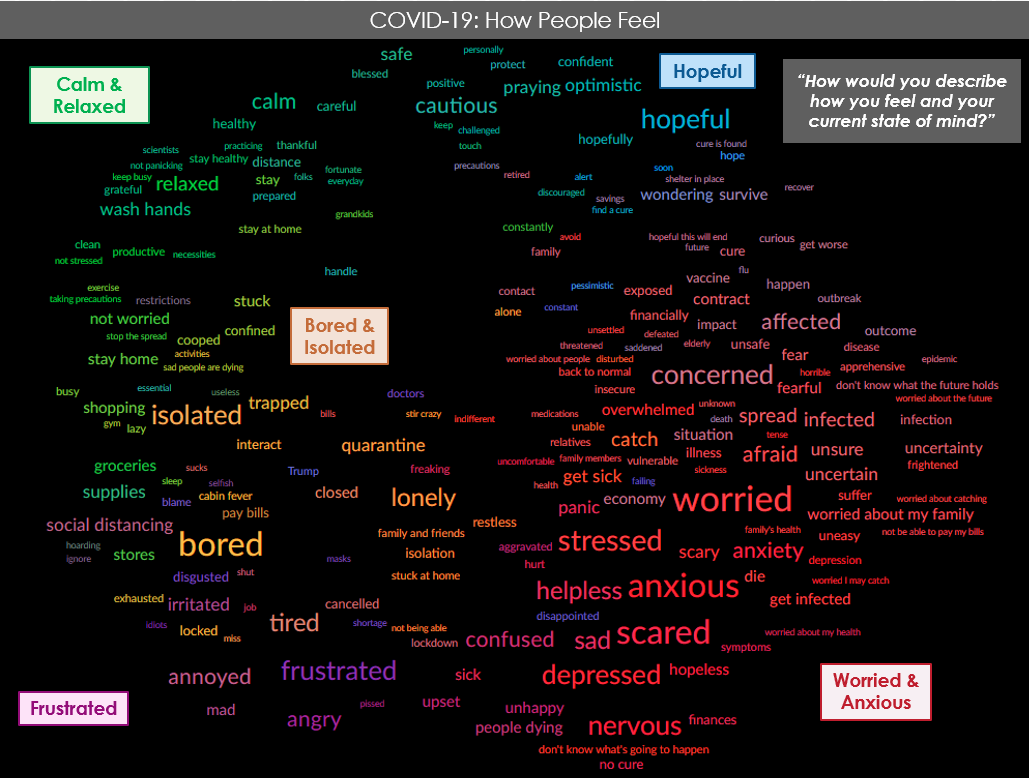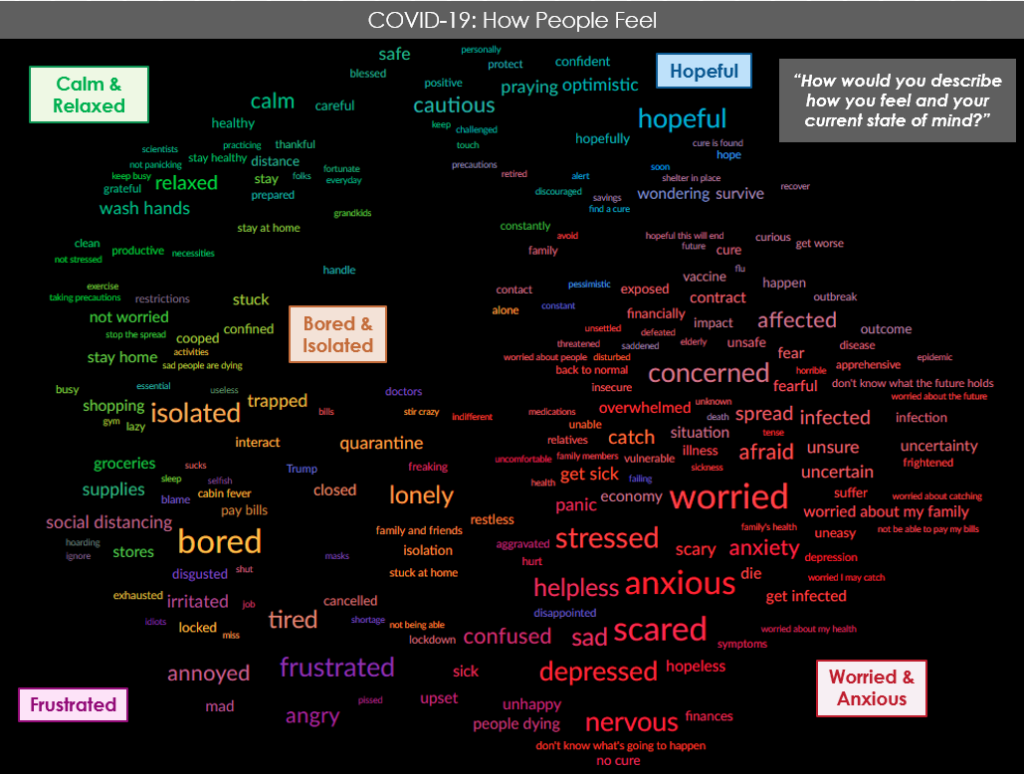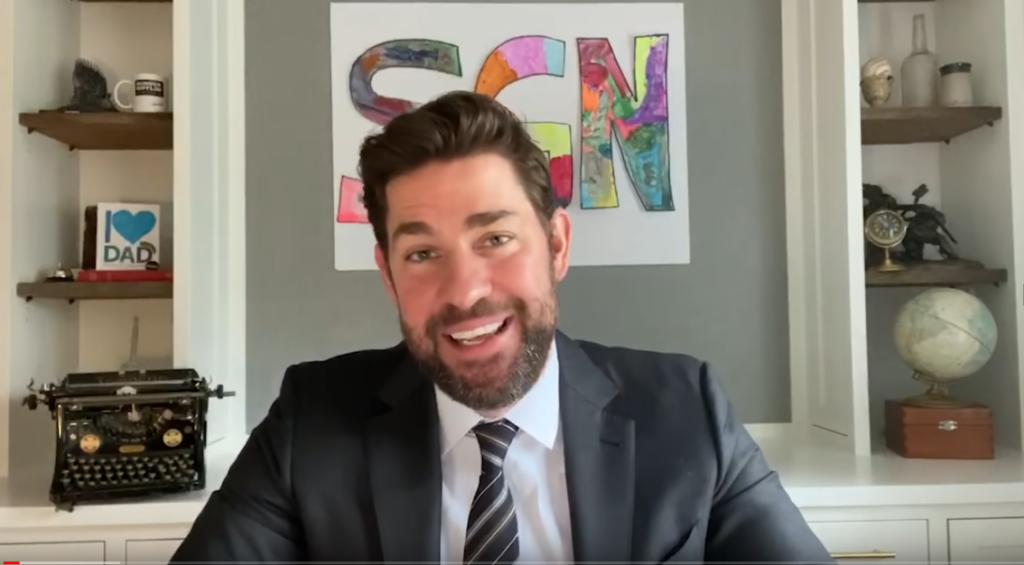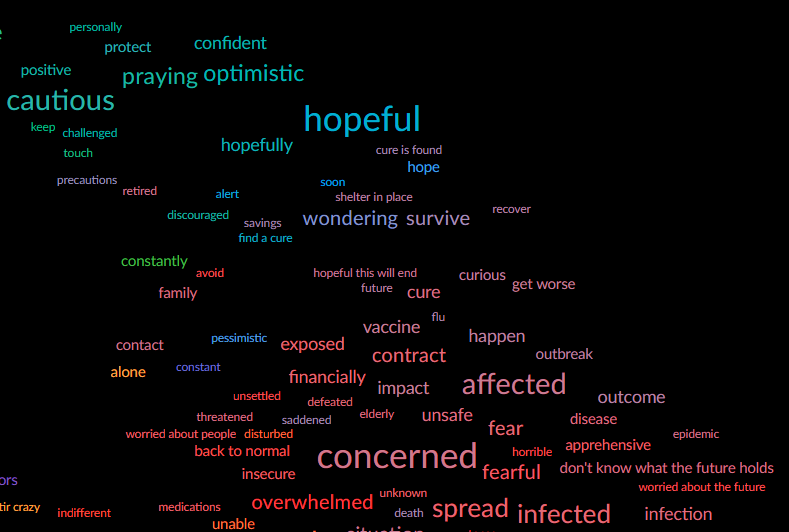As part of our continuing exploration of consumers’ behaviors and attitudes during the current COVID-19 outbreak, MAi/Pathfinder has used our unique methods to explore the emotional impact the current situation is having on the public.
In our tracking study we are asking consumers to describe in detail their current feelings and state of mind as they relate to the coronavirus outbreak. Applying our Pathfinder Text Science methodology to these open-ended questions reveals that consumers’ current emotions fall into five distinct emotional themes:
The ‘How People Feel’ Map reveals the current state of mind of n=1,130 consumers.
Note: When reading a Pathfinder Text Science map, the size of a word reflects its overall importance to the data set; its proximity to other words shows the strength of the association between them; and its color reflects its connection to the map’s main themes.
Worried & Anxious: A sense of anxiety is by far the dominant emotional theme and seems to focus primarily on:
-
- Health concerns both for respondents’ own health and that of their families — particularly older family members;
- Economic anxiety driven by job insecurity — which in turn involves potential loss of healthcare coverage.
Additionally, widespread and unanchored uncertainty about what the future will bring is a factor for many, encompassing a sense of helplessness and lack of control. Unsurprisingly, these strong negative emotions are also fueling high levels of stress for many.
“I’m scared. What if my husband gets laid off and we have no health insurance? What if my mom gets sick and doesn’t receive treatment? What if she has to die alone in a hospital?”
“I feel anxious because we don’t know what’s coming. There’s very little we have control over at this point.”
“I’m stressed about my finances. Unsure of what’s going to happen. Overwhelmed — everything is too much to handle.”
Bored & Isolated: The strict social distancing measures and stay-at-home orders in place across much of the US are also taking a toll, driving strong feelings of boredom, isolation and loneliness. Indeed, bored is the third strongest term on the map, just behind worried and anxious, and suggests a national case of ‘cabin fever’ that is only likely to grow as precautionary measures continue through the coming weeks.
“I’m bored being cooped up in my apartment. I’m not leaving the house for anything, and sitting around all day and night is starting to make me nuts. I need to get out and walk in the fresh air.”
“I feel trapped. I just want to live my life. I need to get out of the damn house. People are not meant to be socially isolated.”
Frustrated: Closely connected to feelings of boredom and anxiety is a sense of frustration driven by people’s inability to do much to affect the situation. Even things as routine as exercise or shopping or getting a haircut have become a source of frustration for many. These feelings of frustration are also closely linked to anger, which is mostly directed at:
-
-
- Other people who aren’t being cautious enough, or are selfishly buying and hoarding essential supplies;
- Public leaders who are seen as not doing enough to mitigate the coronavirus outbreak.
-
“I’m angry because there are some people that are not taking this as seriously as they should. This isn’t a snow day — they need to take responsibility for their actions. They need to stay home.”
“I am angry that the government and our own people aren’t doing more to limit the spread.”
Some Good News:
As John Krasinski highlights in his charming YouTube videos “Some Good News,” there are some positives to be found. Our results show consumers aren’t entirely tied up in negative emotions—we also see two themes that reflect how some are maintaining a positive attitude despite the challenging situation:
Calm & Relaxed: While social distancing and staying at home gives rise to feelings of boredom and isolation for some, others are handling the situation with a sense of equanimity, remaining calm and relaxed despite everything going on around them. (We’ll be investigating the role that demographic, regional, and other differences may play in these diverse attitudes in the coming days.)
“I’m relaxed and calm. I’m staying home and there are very few cases where I live. I feel that there is no real need to worry. I have plenty of things to do to keep myself entertained.”
“I’m pretty calm about it. I’m not panicking but I am cautious. I’m not really bothered as it doesn’t affect my current lifestyle.”
Hopeful: Despite everything, some are holding onto a sense of hope about the future. Our data suggests that roughly 1 in 5 respondents expressed a hopeful sentiment, though it was often couched alongside one or more of the dominant negative emotions. Indeed, the map demonstrates how the hopeful theme intersects with worry and anxiety to show consumers as cautiously optimistic. They acknowledge the current danger but anticipate that events will take a turn for the better in the not too distant future.
“My hope is that people will take to heart the need to isolate and limit interactions with others and that the numbers of infected people may soon begin to decrease.”
“I’m hopeful, and proud of how we are coming together as a country.”
Potential Implications:
Now stepping back and considering this complex emotional palette overall, what can companies and brands take away from the data? It’s important that brands avoid the temptation to lean into vaguely positive “feel good” messaging and instead address opportunities to engage emotionally with what customers are feeling right now in ways that work for the product/company’s unique selling proposition. Here are a few possible implications:
Address consumers’ worry and anxiety.
With so many people feeling worried and anxious, any brand that can empathize with and (if appropriate) resolve these feelings stands to make an impact on consumers. The data suggests three primary drivers of this anxiety: concerns about health, concerns about finances, and a general sense of uncertainty. Helping to alleviate any one of these is likely to be an effective messaging strategy in the coming months.
Additionally, the data suggests that hope acts as a powerful remedy to anxiety for at least some consumers, so a brand or product that can offer hope in some form is also likely to make an impact.
Alleviate feelings of boredom and isolation felt by consumers trapped in their homes.
With most of the country under stay-at-home orders, feelings of boredom (not having anything to do) and isolation (feeling cut off from others) are only likely to grow in the coming weeks. A wide variety of companies in the entertainment, communication, and exercise spaces are well positioned to address these negatives. Creative positioning against these feelings might work for other types of products as well (crafts and hobbies, recreational equipment, home improvement, etc.).
Emphasize feelings of calm and relaxation.
Our data suggests that one person’s isolation is another’s relaxation, so brands that can help consumers turn their ‘house arrest’ into ‘staycation’ have a great opportunity to make inroads with a (literally) captive audience. As one respondent put it:
“I’m staying positive with affirmations and reading positive things. Creative isolation — writing, decluttering, painting, completing photo projects. Staying in touch with friends and family via calls and emails and social networking many times a day.”
Ultimately, these unique times create a major opportunity to bond with our customers. We can’t solve the problem for them, but we can demonstrate that we are in this with them. Using messaging that’s emotionally in sync with their concerns and their hopes shows that we care about our customers, our communities, and our world.
MAi Research/Pathfinder will be continuing to track consumer sentiment around these and other emerging issues over the coming weeks. For more information about Pathfinder Text Science or this research in particular, please contact us to set up some time for us to take you through our findings.













